Materials Technology: Melt-on-demand Adhesives
Melt-on-demand adhesives technology changes the game
The recent innovation of melt-on-demand technology is changing the adhesives and sealants market for the better, speeding up production and saving money and resources.

Graco InvisiPac Tank-Free Hot Melt Delivery System

InvisiPac GM100 Plug-Free Applicator

InvisiPac Melter



According to Graco, a world leader in fluid handling products and systems, “knowing is the first step to saving.” In the past, hot melt adhesives systems have kept end users guessing – guessing if they’re using the right amount, if they could be using less, and how could they cut costs while also speeding up production and reducing energy and resources.
All of this and more is what the innovative new InvisiPac® Tank-Free™ Hot Melt Delivery System is giving to the hot melt adhesive industry. After launching the “We’ll Prove it or We’ll Move It” campaign back in August 2015, where new customers could try the innovative system free for 90 days, Graco (graco.com) introduced the packaging industry to cost savings and reduced maintenance they have not had before, all thanks to the company’s InvisiPac Tank-Free Hot Melt Delivery System, changing the adhesives landscape for the better.
“From an adhesives standpoint, Graco is really the expert in fluid handling,” says Anne Jones, marketing manager for Graco. “We create the systems that dispense and apply the different materials that are needed in many and all applications. Specifically for end of line packaging, we have InvisiPac.”
Up until recently, the market has only been using a “crock pot,” system for melting adhesives. According to Jones, InvisiPac is the first and original tank free system to the market, changing the game. Helping to move away from this crock pot style, InvisiPac is truly melt-on-demand, where the adhesive comes into the system, goes through an innovative melting process and melts as you need it.
“This is unique to the market because it provides an avenue for users to apply adhesives consistently, where they are able to measure it due to our innovation and pumping mechanics,” says Jones. “End users are able to control adhesive dispense, which at the end result, provides visibility to the end user to understand and find the correct amount of adhesive needed for their package.”
So why is this important? According to Jones, from a manufacturing standpoint, it’s all about overall equipment effectiveness. How can an end user get the most out of their equipment? How can they get the most out of their production? And how can they continue to ramp of the production without effecting quality?
The InvisiPac system and process is solving these adhesive industry issues with melt-on-demand technology. A major aspect in this problem solving is that with this system, users aren’t getting the built up char that comes into the system, which is an unfortunate commonality when using a tank system.
“This is unique to the market because no one else really has this melt-on-demand technology,” explains Jones. “They may say they do, but it is not the process that [Graco] uses.”
Not only did current industry trends and needs impact the creation of the new melt-on-demand systems in the first place, but with the creation came new trends, as well as new wants and needs from customers.
“One of things we’re starting to see and hear about is because of the innovative abilities of InvisiPac, adhesives manufacturers are pushing the envelope in terms of the technologies that are available,” says Corey Johnson, global product manager for Graco. “What that means is we’re starting to hear about adhesives that had previously been shelved are now coming off the shelves and starting to be looked at again because equipment wasn’t able to process it properly.”
According to Johnson, technologies that were not available to be utilized before are now available thanks to melt and dispense technology advancing. “Each of these technologies is all a little bit different,” he says. “You’ll start to see people coming out with high mileage fluid adhesives, environmentally friendly adhesives, and a lot of different and more options. Now the adhesives technology is actually starting to catch up in terms of opening the door on what manufacturers can do with the adhesives.”
From a sustainability stand point, “when you have the melt-on-demand, you have an efficient use of energy” says Johnson.
This has to do with the amount of energy, electricity and materials that are needed. The InvisiPac system requires considerably less compared to older technologies. “Because of older technologies, slow start ups and other parts of their processing, customers usually don’t ever turn their tanks off,” says Johnson. “So even if they’re not running - their tanks are still consuming energy and [InvisiPac] doesn’t have that disadvantage.”
When it comes to materials, another trend Johnson is seeing is petroleum low on the price scale due to their accessibility. However, he believes this trend isn’t going to last forever, and eventually metallocenes are going to push themselves back up and distance themselves away from EDA’s (ethyleneamines).”
Because of this, Johnson says end users will turn to EDA’s, which are less costly to produce. A disadvantage to that is that they cannot handle high temperatures over long periods of time; this means they char more easily than metallocenes, pushing customers toward other options. According to Johnson, with the InvisiPac system and melt-on-demand capabilities, the EDA market is opening back up again.
Overall, the way InvisiPac is processing materials is in turn opening up the doors for material suppliers to innovate and integrate different chemistries.
“We’re opening the doors for that innovation to happen when before material suppliers were handcuffed because of that crock pot technology that everyone was used to,” says Jones.
Melt-on-demand adhesives seem to be a clear and promising future for the market. Because of the InvisiPac system, users can finally measure and track the amount of adhesive they are using and apply the right, not too much amount, giving them the control and visibility the industry has been needing and wanting.
Looking for a reprint of this article?
From high-res PDFs to custom plaques, order your copy today!











